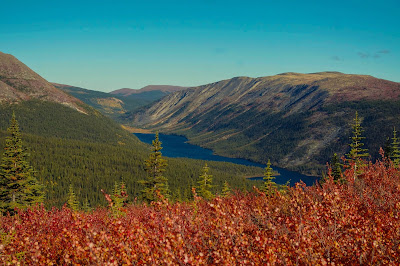Yesterday, I visited the raven's nest. The snow on the snowmobile trail was hard and crusted on this warm mid-April morning, and after a five-minute walk through the boreal forest, I reached a straight stretch in the trail and stopped. Ahead, in a clearing, was the raven's nest high in a towering poplar. From here, I could study the nest while remaining hidden in the trees.
I had discovered the nest in early March while x-country skiing on a snowmobile trail that cut through the old logged site. Willows and alders poked through the snow while towering thick poplars, bare of lower branches, dotted the landscape. At the far edge of the clearing, where the track dipped back down into the spruce and pine, I found the snow-covered nest of sticks built where the tree trunk divided into multiple branches. Fifty feet from this nest, in another poplar, was a second smaller nest. Why so close? I had read that ravens don't nest close to each other. Had a nesting pair built one, abandoned it and built another?
A few weeks after my discovery, I ventured up the snowmobile trail to the clearing. The snow had melted off the nests. Ravens flew high overhead and passed out-of-sight. From the edge of the clearing, I focused on the larger nest. No movement. As I lowered my binoculars a raven flew past the nest. Darn! Had forgotten to look at the smaller nest. I waited for the raven to return. A big raven flew toward me and landed on a tall spruce behind me and proceeded to cry out his deep territorial
quorks. The female returned and settled onto a spruce near the nests. The male flew to the female and sat on a branch above the female. The male's wings trembled; the female's wings trembled and her tail wagged. Then, the female flew down the clearing followed by the male. The birds didn't return.
Early April and I returned for another check. As soon as I stepped off the road and onto the trail, I heard the male's deep voice calling. When I reached the clearing, I saw the female sitting in a spruce across from the nests. After a moment, she flew away followed by the male.
Near me a deep-throated tiny buzz sounded and two red squirrels scrambled down a tree and onto the crusted snow. They sped across the trail and, with one squirrel following close behind the other, the pair zig-zagged over the snow and into the forest. Silence.
Buzz, buzz - I swung around and spied the squirrels racing towards me before veering off to sprint down the trail. As the squirrels disappeared, the female raven flew back and settled into a spruce. She didn't move, so I walked down the trail into the forest and turned around. In the poplar tree, the female sat on a branch beside the smaller nest. She sidled down the branch, stepped into it and settled down until her body disappeared. The pair was nesting!
Yesterday when I returned, the nest was quiet. No ravens called or flew. Were they still there? The male appeared and with flapping wings and spread-out tale, he landed on the branch beside the nest. The female hopped out, grabbed something from the male's beak, and hopped back into the nest while the male flew away. She must be incubating!
Incubation is for twenty-one days and I've calculated roughly when the eggs could hatch. Hatchlings stay in the nest for 6 weeks where they will reach adult weight. When they leave the nest, they stay with their parents for another 6 to 8 weeks as they learn to forage.
Nature has given me a gift as I watch the progress of the nesting ravens.






















